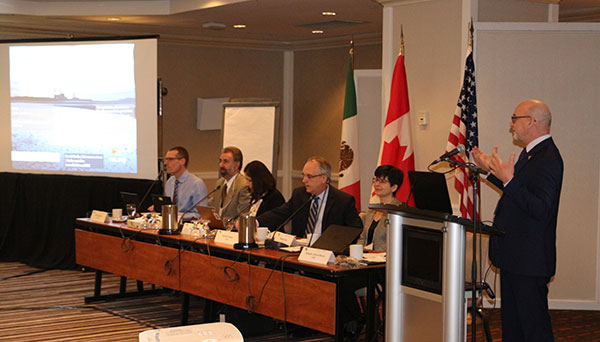Réunion publique de l’Initiative RRTP de l’Amérique du Nord
Delta Hotel,
475 Avenue du Président-Kennedy,
Montreal, Québec
Canada
25 et 26 février 2020
Publique
Cette réunion, organisée parallèlement à l’atelier des utilisateurs des données de l’Inventaire national des rejets de polluants (INRP) du Canada, réunira des représentants de l’industrie, des gouvernements, d’organismes non gouvernementaux, du monde de la recherche et du public qui s’intéressent à la viabilité environnementale au sein de l’industrie nord-américaine.
- Jour 1 (animé par les représentants de l’INRP) : on parlera des utilisations spécialisées des données de l’INRP pour comprendre les besoins en information des utilisateurs et la façon de mieux y répondre. Les universitaires et les chercheurs expliqueront comment ils utilisent les données de l’INRP et les liens qu’ils établissent avec d’autres données. Les utilisateurs débutants comme chevronnés sont les bienvenus.
- Jour 2 (animé par la CCE) : on explorera les utilisations courantes et possibles des données du RRTP de l’Amérique du Nord pour mieux comprendre les besoins des intervenants sur le continent et y répondre plus efficacement. Les participants pourront entendre les représentants des trois RRTP qui feront le point sur les programmes; explorer les thèmes qui pourraient être analysés dans le prochain rapport À l’heure des comptes; voir les améliorations apportées au site Web À l’heure des comptes en ligne, aux données et aux outils de la CCE; et proposer des suggestions pour un projet « défi » en matière de prévention de la pollution dans l’industrie nord-américaine.
La participation à la réunion est gratuite, mais le nombre de places est limité et tous les participants doivent s’inscrire. Les participants admissibles peuvent recevoir une aide financière pour le déplacement et l’hébergement. Vous avez jusqu’au 10 janvier 2020 pour présenter une demande d’aide financière.

Ordre du jour
25 février : Atelier des utilisateurs des données de l’INRP
Objectifs :
- Mieux comprendre les besoins des utilisateurs avancés des données de l’INRP provenant du milieu universitaire, de la recherche et du gouvernement, par exemple :
- Quelles données de l’INRP sont utilisées par ce public?
- Comment les données sont obtenues et comment sont-elles utilisées?
- À quels autres types de données sont-elles associées?
- Illustrer la polyvalence de l’INRP en mettant en valeur le travail de divers utilisateurs de données;
- Créer une plate-forme où les utilisateurs de données peuvent interagir entre eux afin de partager les meilleures pratiques et les leçons apprises en utilisant les données de l’INRP.
Inscription
(15 mins)
1 – Mot de bienvenue
Objectifs de la rencontre, aperçu de l’ordre du jour, logistique et session de remue-méninge qui servira à alimenter un exercice de réflexion conceptuelle.
(15 mins +10)
2 – Sondage d’opinion publique quant à l’INRP
Survol des résultats du récent sondage sur l’opinion publique mené par l’INRP et les Associés de recherche EKOS.

(15 mins +10)
3 – Nouveau site de recherche, produits de données et d’information de l’INRP
Un aperçu des récents changements apportés au site de recherche de l’INRP, aux produits de données (données brutes) et aux produits d’information (données interprétées, p. ex. fiches de renseignements) pour améliorer l’expérience des utilisateurs de l’INRP.

(15 mins +10)
4 – Point de vue des journalistes
Deux journalistes du Journal de Québec et du Journal de Montréal partageront leur expérience en matière de reportage au sujet de la pollution à partir des données gouvernementales.

Journal de Québec Annabelle Blais, Journal de Montréal
Télécharger la présentation
Pause (café et thé fourni)
(25 mins +10)
5 – Explorer la colocalisation entre les effets indésirables à la naissance et les variables environnementales
Un résumé de quatre études abordant les thèmes suivants : 1) l’identification des émissions chimiques industrielles colocalisées avec les effets indésirables à la naissance au Canada; 2) élaboration d’un indice de danger ambiant pour la santé en Alberta; 3) formulation d’hypothèses sur la colocalisation de mélanges de polluants atmosphériques industriels et d’effets indésirables à la naissance; et 4) modélisation spatiotemporelle des zones sensibles.

(15 mins +10)
6 – Exposition aux polluants atmosphériques industriels liés au biomarqueur pour la polyarthrite rhumatoïde
Étude sur l’association entre les anticorps anti-citrullinées (ACPA) et la présence de particules fines de polluants (PM2.5) dans l’air ambiant, ainsi que la présence de dioxyde de soufre (SO2) au Québec.

(15 mins +10)
7 – Application des données de l’INRP dans la répartition des sources, à l’analyse des tendances décennales et aux études de dépôts atmosphérique sur les polluants surveillés
Étude de la contribution des sources de mercure atmosphérique, de polluants acidifiants et d’hydrocarbures aromatiques polycycliques dans la région des sables bitumineux du Canada.

(30 mins)
8 – Exercice de réflexion conceptuelle
Un exercice de réflexion conceptuelle sur papier visant à faire ressortir les besoins des utilisateurs de données. L’exercice sera expliqué et ensuite exécuté par les participants.
Dîner (fourni)
(15 mins +10)
9 – Aperçu du programme de l’Inventaire national des rejets de polluants du Canada en tant qu’outil stratégique de lutte contre la pollution
Cette étude examine et explore d’un œil critique les objectifs en matière de politiques publiques de l’INRP du Canada par rapport à d’autres registres des rejets et transferts de polluants (RRTP).

(15 mins +10)
10 – Intégration de modèles multimédias de bilan massique pour relier les données de l’INRP à l’exposition et l’évolution de produits chimiques dans l’environnement et à la possibilité d’effets néfastes
Une étude de cas utilisant le modèle RAIDAR (Risk Assessment IDentification And Ranking) pour évaluer 252 produits chimiques organiques de l’INRP afin de déterminer leurs effets nocifs potentiels sur les humains et l’environnement en évaluant les dangers (« PBT »), l’exposition et les risques.

(15 mins +10)
11 – L’INRP pour la comptabilisation et la modélisation des répercussions de la pollution de l’eau sur l’économie des Grands Lacs
Une présentation sur la création d’un cadre intégré de comptabilisation des bassins hydrographiques, reliant les activités économiques à l’eau comme source et puits, en utilisant le bassin des Grands Lacs en Ontario comme étude de cas

(15 mins +10)
12 – Qu’est-ce qui influence les tendances de rejets de polluants?
Une enquête sur l’emplacement des entreprises et des décisions de trie des ménages en Ontario.

(15 mins+ 10)
13 – Comment sont utilisées les données de l’Inventaire des rejets toxiques (TRI) par les universitaires et les autres chercheurs?
Aperçu des programmes et des projets de l’EPA des États-Unis qui se servent des données de l’Inventaire des rejets de substances toxiques des États-Unis pour mieux comprendre la pollution.

(40 mins)
14 – Table ronde
Plusieurs présentateurs (Charlene Nielsen, Stuart J. Edwards, Roy Brouwer, Burc Kayahan, Charles Lecavalier) agiront en tant que panélistes pour partager leurs différents points de vue sur l’utilisation de l’INRP
Animée par: Alicia Berthiaume
(10 mins)
Mot de la fin et conclusion
Jody Rosenberger (ECCC)
26 février : Réunion publique de l’Initiative RRTP de l’Amérique du Nord
Atelier des utilisateurs des données de l’INRP / Réunion publique de l’Initiative RRTP de l’Amérique du Nord
Inscription
Session 1 : Introduction et objectifs de la réunion – Orlando Cabrera-Rivera, chef d’unité, Qualité de l’environnement, CCE
Mot de bienvenue – Richard Morgan, directeur exécutif de la CCE
Session 2 : Initiative de RNARTP : Le point sur les activités – Orlando Cabrera-Rivera et Danielle Vallée, Unité de Qualité de l’environnement, CCE

et Danielle Vallée
Unité de Qualité de l’environnement, CCE
Télécharger la présentation
Session 3 : Le point sur les programmes nationaux de RRTP

United States’ Environmental Protection Agency (EPA, Agence de protection de l’environnement des États-Unis)
Toxics Release Inventory (TRI, Inventaire des rejets toxiques)
Télécharger la présentation

Secretaría de Medio Ambiente y Recursos Naturales (Semarnat, ministère de l’Environnement et des Ressources naturelles), Mexique
Registro de Emisiones y Transferencia de Contaminantes (Registre des émissions et transferts de contaminants)
Télécharger la présentation

Environnement et Changement climatique Canada
Inventaire national des rejets de polluants
Télécharger la présentation
Pause
Session 4 : Examen des utilisations actuelles et possibles des données des RRTP nord-américains

University of California, Irvine
Utilisation des données RETC du Mexique pour évaluer les risques pour la santé publique liés aux émissions toxiques
Télécharger la présentation

Toronto Public Health
Dix ans du programme ChemTRAC de la Ville de Toronto: Leçons apprises
Télécharger la présentation

Aamjiwnaang, et Kristen Bos, Technoscience Research Unit, Université de Toronto
L’application «Pollution Reporter
Dîner (fourni)
Session 5 : Répondre aux besoins des utilisateurs des données des RRTP nord-américains : Discussion
On demandera aux participants de parler de leur expérience d’utilisation des RRTP, et de suggérer des façons de remédier aux difficultés identifiées.
Session 6 : Suggestions pour le prochain rapport À l’heure des comptes : Discussion
On demandera aux participants de donner leur avis sur de possibles analyses qui pourraient être intégrées au prochain rapport À l’heure des comptes.
Pause
Session 7 : Idées pour l’organisation d’un défi nord-américain pour la prévention de la pollution (Panel) – Gary Vegh, ERA Environmental Management Solutions; Paola Hernandez, Grupo México; Sandra Gaona, U.S. EPA
Parmi les questions à explorer lors de cette discussion :
- Les efforts de durabilité de l’industrie se reflètent-ils dans les données RRTP?
- Quels sont les obstacles à la mise en œuvre de pratiques de prévention de la pollution/de production durable?
- Quelles sont les approches réalisables pour une initiative volontaire de prévention de la pollution de l’industrie nord-américaine?
Session 8 : Prochaines étapes et mot de la fin – Orlando Cabrera-Rivera, CCE